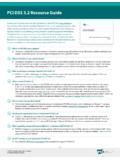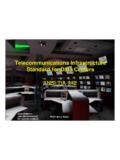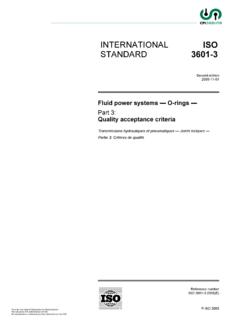Transcription of National BIM Standard - United States Version 3
1 National BIM Standard United States Version 3 2015 National Institute of Building Sciences buildingSMART alliance . All rights reserved. National BIM Standard - United States Version 3 4 Information Exchange standards Construction Operation Building information exchange (COBie) Version CONTENTS Scope .. 2 Normative References .. 17 Terms and definitions .. 22 Symbols and abbreviated terms .. 45 Business process documentation .. 47 Exchange requirement documentation .. 92 Conformance testing procedures .. 221 Implementation resources .. 236 Revision plans .. 243 Bibliography .. 245 Table of Figures.
2 248 Annex A COBie Mapping Rules .. 252 Annex B Life Cycle information exchange (LCie) for Product and Product Type data exchanges, a technical Annex to COBie Verion .. 252 INFORMATION EXCHANGE standards COBie-Page | 2 National BIM Standard United States Version 3 2015 National Institute of Building Sciences buildingSMART alliance . All rights reserved. Scope Business Case Description Author s Editorial Comment: Business process models supporting COBie were first documented in a Army Technical Report (East 2007). These business models were developed from a series of industry advisory panel meetings conducted in 2006 and 2007.
3 Additional clarification of the scope of processes pertaining to the life-cycle of facility assets were proposed in East 2010. At the time of submission of this document another update to COBie-related business processes is being finalized for editing as part of a Army Technical Report (Fallon 2013). The objective of the research contained in this report was to use business process modeling in conjunction with lean management approaches, as in East 2011, to compare current with COBie-based business processes. As part of the NBIMS-US V3 COBie Standard , an updated set business models developed in the latest report is provided for direct inclusion in the Standard .
4 Based on the rules NBIMS-US V3 Technical Subcommittee Evaluation Criteria for Revised information exchange submissions, the information provided in this section should be considered a Moderate Change. Life-Cycle Phase List Study and Define Needs Develop Design Criteria Study Technical Feasibility Communicate Results Decision Develop Program Space Program Develop Program Product Program Prepare Invitation to Bid and Receive Proposal (Pre-Design) Explore Concepts Design Early Develop Design Design Schematic Develop Design Design Coordinated Finalize Design Design Final Prepare Invitation to Bid and Receive Proposals (Post Design)
5 Respond to Pre-Proposal Inquiries Develop Pre-Construction Plan Identify Discrepancies Prepare Submittal Information Product Type Selection Prepare Submittal Information System Layout Organize Submittal Information Perform Submittal Review Submittal Issue Provide Resources Execute Construction Activities Perform Equipment Testing INFORMATION EXCHANGE standards COBie-Page | 3 National BIM Standard United States Version 3 2015 National Institute of Building Sciences buildingSMART alliance . All rights reserved. Inspect and Approve Work Define, Record and Certify Discrepancies Closeout While the use of shared, structured information, such as COBie, can be shown to have a direct have an impact on the speed and quality of value-added tasks, the business cases described below do not consider these beneficial effects.
6 This is because in a generic model, such effects were too complex to model in the first study of the life-cycle impact of having COBie data. As a result, the business cases described here are conservative in their estimates. COBie business cases are based on the value-added analysis technique published in East 2010. This approach organizes work operations into tasks that add value to the final product and those that do not. Work operations that do not add value are targeted for elimination in the streamlined business process. The following opportunities for streamlining the production, exchange, use, and maintenance of COBie data through the elimination of non-value added operations are characterized by the following classification: 1.
7 VALIDATION savings from the ability to programmatically check the space and equipment data for completeness, conformance to standards and conformance to requirements. 2. COPYING savings from reliance on electronic documents and data as the project record. 3. HANDLING savings from the adoption of managed project collaboration and management systems for transmittal and automated logging of project documents. 4. SEARCHING savings from the ability to electronically compare product data to product specifications. 5. REFORMATTING savings from adoption of a single, open Standard data format for information relating to managed assets.
8 6. RECREATING savings from the use of a Standard , structured data format for moving space and equipment information through the project process and into facility management, eliminating the need for data re-entry. In addition, rework is a form of recreation. Savings can be achieved in non-value added tasks to different degrees. Some tasks can be completely eliminated, while others can be automated or streamlined. Of the 25 life cycle processes studied in Fallon 2013, 19 of these would obtain a savings from the expected approach. The following processes are defined and include the analysis of possible savings from the use of COBie-based information exchanges.
9 Study and define needs Standard facility information must be available in order to determine the basic requirements for a potential project. The Owner identifies the need and either develops technical criteria for the facility if none exist or utilizes existing technical criteria if available. If it does exist, this information must be checked for relevancy every five years to remain consistent with overall needs. Potential savings in this process include, but may not be limited to, the following: Reproduction savings from reliance on electronic documents and the elimination of paper. INFORMATION EXCHANGE standards COBie-Page | 4 National BIM Standard United States Version 3 2015 National Institute of Building Sciences buildingSMART alliance.
10 All rights reserved. Develop design criteria Specification information for equipment based on facility criteria is generated early in the planning process by the Owner. This information must be checked for relevancy every five years to remain consistent with overall needs. Potential savings in this process include, but may not be limited to, the following: Reproduction savings from reliance on electronic documents and the elimination of paper. Study technical feasibility The Feasibility Study allows the Owner to evaluate different options (typically three) based on the identified requirements before finalizing specific information about a project.







